Templevanny
Houses within 15km of this house
Displaying 85 houses.
Houses within 15km of Templevanny
Displaying 85 houses.
| House name | Description | |
|---|---|---|
| Hollybrook | This house was built in the 1750s as a successor to an earlier castle. The estate passed to the Phibbs family later in the 18th century and Wilson refers to it as the seat of William Phibbs in 1786. It was later bought back by another member of the ffolliott family. McParlan described it as "a very good house" in 1802. At the time of Griffith's Valuation it was the property of John Ffolliott. In 1906 it was the property of Agnes ffolliott when the house was valued at £55. During the twentieth century Hollybrook was run as a hotel for a number of years but it is now privately owned. The house is still standing but does not appear to be occupied. |

|
| Corradoo Lodge | At the time of Griffith's Valuation William Phibbs was leasing the property at Corradoo, barony of Tirerrill to Major Kingston Lloyd when it was valued at £18. Lewis records it as a residence of William Phibbs. McTernan notes that it was originally built by the Phibbs estate as a schoolhouse but was later converted into a residence. It was leased, and later sold to, the Frazier family. Following the deaths of the last of that family it was demolished and a new house built at the site. | |
| Lakeview (Kilmacallan) | Johnston states that Lakeview House was built sometime in the 1780s. It is recorded as a seat of the Weir family throughout the nineteenth century. At the time of Griffith's Valuation it was held by the representatives of William Weir and was valued at £10. Johnston asserts that the house was sold in 1863 and was occupied in the 1870s by Bernard Cogan. It is no longer extant. | |
| Heapstown | At the time of Griffith's Valuation James McTernan owned the house at Heapstown valued at £3 but part of a land holding of 100 acres. Lewis had recorded Heapstown as the seat of Martin Manning in 1837. In 1906 Heapstown was valued at £15. McTernan states that this was the house built after the Famine by Hugh McTernan. This house was eventually demolished in the 1950s. | |
| Doobeg | At the time of Griffith's Valuation the property at Doobeg consisted of a herd's house, valued at over £1, together with over 300 acres, and was in the ownership of Robert McAlpine. In the later nineteenth century it was lived in by the Phibbs family. Doobeg house is still extant and occupied as a family home. | |
| Coolavin | McParlan described the Coolavin of 1802 as a "delightful retreat". The house at Clogher was offered for sale as part of the McDermott estate in 1852. By the time of Griffith's Valuation it was occupied by Joseph Holmes and was valued at £16. In 1906 Coolavin was valued at £35. The house now known as Coolavin was built in the 1890s replacing an earlier house near the same location. This latter house is still extant and occupied. The original house at Clogher is now derelict. |

|
| Redhill | At the time of Griffith's Valuation, William Baker was leasing a property valued at £14 at Mullaghroe, barony of Coolavin, from Viscount Lorton's estate. Lewis recorded Redhill as the seat of Andrew Baker in 1837. The house remained in the Baker family until 1912. It is still extant and occupied. |

|
| Mount Irvine or Mount Irwin | At the time of Griffith's Valuation Edward B. Thornhill held over 300 acres including the townland of Mount Irvine and a property described as offices, valued at £3. Lewis had recorded Mount Irvine as the seat of William T. Sherlock in 1837. This house is more usually known as Mount Irwin and was a seat of the Irwin family in the eighteenth century. It passed by marriage to the Thompsons and then to William Theophilus Sherlock. It was later sold in the Encumbered Estates Court and the Thornhills continued to own it until 1907 when it was sold to the Land Commission. Nothing remains of the original house. | |
| Cuilmore | At the time of Griffith's Valuation, James Powell was leasing a property valued at £7 with over 150 acres, from Lord de Freyne's estate, at Cuilmore, barony of Coolavin. The original house is not extant now. | |
| Lisserlough | Lisserlough was part of the King (Viscount Lorton) estate but was let on long leases to a number of different families, notably Powell, Baker and Laurence. McTernan notes that the present house was built by Viscount Lorton in the 1850s. It is still extant and has been restored while the adjacent out-offices have been converted into apartments. | |
| Rathtermon | Taylor and Skinner indicate Rathtermon as a seat of the Fleming family in 1783. In 1837 Lewis records Rathtermon as the seat of J. Flanagan. At the time of Griffith's Valuation, Rev. John Flanagan was leasing a property valued at £10 together with over 200 acres at Rathtermon, barony of Coolavin, to Phillip McDermott. Rathtermon is still the focus of a large farming enterprise. |

|
| Flower Hill | Flower Hill was being leased by Magdalene Irwin from the Perceval estate at the time of Griffith's Valuation when it was valued at £3. The Irwins had a modest house at this location and in the 1820s set about building a larger property. Due to debt and court proceedings it was never finished and remains a roofless ruin. | |
| Old Rock | At the time of Griffith's Valuation John Trumble was leasing a property valued at £4 at Old Rock, barony of Corran, from Johnston Parke. McTernan states that John Trumble eventually disposed of his interest in this property and settled in Manchester. The original house is no longer extant. | |
| Temple House | The Temple House estate extended into the Civil parishes of Cloonoghill and Emlaghfad as well as in the parish of Kilvarnet where the house is located. In 1786 Wilson refer to Temple-house as the seat of Mr. Perceval. The present house was built c.1820 but was subsequently modified. In 1894 the house was noted by Slater as the seat of Mrs. Perceval. Remains of earlier Perceval houses are to be seen in the demesne. |

|
| Greyfort | Alexander Perceval was the lessor of a property valued at almost £6 at Lislea, barony of Corran, which he was leasing to James Dale at the time of Griffith's Valuation. McTernan notes the house as the seat of the Rea family from the mid-seventeenth to the mid-nineteenth centuries. A number of other families occupied the house up until the 1980s when it was demolished. | |
| Abbeyville | Abbeyville was originally a Phibbs property. McTernan states that it was leased to William Fleming after the death of William Phibbs in 1785.The original house was built in 1716 but extensively modernised afterwards. In 1814 it was the residence of William Fleming. At the time of Griffith's Valuation it was being leased by James Fleming from William Phibbs and was valued at £6. In the later nineteenth century it passed out of the Fleming family. It was demolished in the later twentieth century. Leet indicates that Archibald Fleming resided at Larkfield, also close to Ballymote. | |
| Drimrane | At the time of Griffith's Valuation John Taaffe was leasing a property at Drimraine, barony of Corran, valued at £6 to John Davis. It was in use as a herd's house accompanying a holding of over 100 acres. McTernan states that Davies subsequently sold the property to the Reynolds family in whose possession it still remains. | |
| Cloonshanbally | Margaret and Henry Gorman were leasing a property valued at £12 at Cloonshanbally, barony of Tirerrill, from the Gore Booth estate at the time of Griffith's Valuation. | |
| Earlsfield | Earlsfield had earlier been a Dodwell property. At the time of Griffith's Valuation it was leased from the Gore-Booth estate by Capt. Richard Gethin and was valued at £20. Slater records it as the seat of Francis Gethin in 1894. It is still extant and has served as a convent for many years. |

|
| Carrowkeel | At the time of Griffith's Valuation John F. MacDonagh held property valued at £12 at Carrowkeel, barony of Corran, from the Gore Booth estate. Lewis also records this as a MacDonagh property, describing it as a "fine modern residence". McTernan notes that Carrowkeel was probably built by Francis MacDonagh at the beginning of the nineteenth century. It remained in the family until its sale in the Landed Estates Court. It is still extant and occupied. | |
| Newpark | At the time of Griffith's Valuation Newpark was being leased by Jemmet Duke from Robert Duke and was valued at £25. Lewis recorded it as the seat of Robert Duke in 1837. McTernan notes that it passed by sale to Richard Edward O'Hara of the Annaghmore family in 1913. The house is still extant and occupied by his descendents. |

|
| Battlefield | McTernan notes that Battlefield was built for the Knott family in the early nineteenth century. At the time of Griffith's Valuation James Knott occupied the property, then valued at £20. Both Leet in 1814 and Lewis in 1837 record Battlefield as a residence of the Knott family. In the later nineteenth century the house passed into the ownership of the Robinson family, descendents of the Knotts. with whom it remained until the 1940s. It was sold and subsequently demolished. | |
| Kilturra | At the time of Griffith's Valuation Joseph Verscoyle was leasing a property valued at £6 together with over 300 acres to Bartholomew McGettrick, at Kilturra, barony of Corran. This later became the residence of John Ormsby Cooke. It was partially damaged by fire in 1920 and Cooke eventually abandoned the property which became derelict. It was demolished in the 1930s. | |
| Rockingham | Sir Robert King, Viscount Lorton, built Rockingham House around 1810 and the family moved there from King House in Boyle. At the time of Griffith's Valuation Rockingham was valued at £180. In 1903 Rockingham became the county residence of the Lord Lieutenant Lord Dudley. It was destroyed by fire in 1957 and subsequently demolished. Only some of the servants' tunnels as well as other estate buildings remain. The site is now occupied by Lough Key Forest Park. |

|
| Tower Hill | At the time of Griffith's Valuation, Richard Gardiner was leasing a property valued at £14 at Carrowkeel, barony of Tirerrill, from Viscount Lorton's estate. He was also renting over 400 acres. McTernan indicates that the family held property in the area since the mid eighteenth century. The original house was damaged by fire in the 1960s but another was built at the site and is still in the possession of the Gardiner family. | |
| Clooskirt | At the time of Griffith's Valuation, Mrs. Ormsby Gore was leasing this property to William Wilson. It was then valued at £12. At the same time Ruttledge Burrowes was leasing a property valued at £4 with over 140 acres of land from the Ormsby Gore estate. Johnston states that a "model farm" was established here in the later nineteenth century. This townland is mentioned as Clooshire, in 1906, when George Ormsby Gore was the owner of the property but there is no valuation given for buildings at that time. It was subsequently lived in by the St. Lawrence family. |

|
| Rockbrook | Rockbrook was originally a Phibbs property. It later came into the possession of Abraham Martin of Cleveragh who leased it to the Cogan family and later to the Lougheed estate. It was occupied by John Lougheed at the time of Griffith's Valuation when it was valued at £3. Johnston states that the estate was divided by the Land Commission in the 1920s and that the house was sold by Mrs. Lougheed in 1938. It burnt down in 1945 and only the ruins remain today. | |
| Cloonamahon | In 1854 when the estate was offered for sale by Thomas James Meredith the house was described as "a good slated dwelling-house..somewhat out of repair, but with a little outlay, it could be made very comfortable". In 1906 Dr. Henry Tweedy was the owner of buildings valued at £50 at the site. Following the departure of the Tweedy family the property was used as a sanitorium and later a retreat centre. McTernan notes that the original house was demolished in 1976 and replaced by modern buildings. Most of the site is now occupied by a Health Service facility. | |
| Lisconny | Lisconny was a property which belonged to the Phibbs family in the eighteenth century. McTernan notes that it had been purchased by them from the Mortimer family in the 1770s. It passed to the Toler family, earls of Norbury, through marriage. At the time of Griffith's Valuation, it was occupied by Bernard Owen Cogan, leasing from Lady Norbury's estate. It was then valued at £20. Lewis also records it as being occupied by the Cogan family in 1837. Johnston asserts that the Cogans acted as agents for Lady Norbury's estate in Ireland. The house was demolished early in the twentieth century. Very few traces remain except some walls of the stable yard and a building which had been an annex to the big house. | |
| Ballindoon House | Ballindoon or Kingsborough House in the townland of Kingsborough was built c.1820. An earlier house, known as Kingsborough, stood on the site.At the time of Griffith's Valuation, John Gethin was in possession of the house at Kingsborough which was valued at £20. In 1906 Percy Gethin owned the property then valued at £22. The house is still extant. |

|
| Coopershill | Coopershill House was completed in 1774. McParlan described its situation as delightful in 1802. Lewis records it as the seat of Arthur Cooper in 1837. At the time of Griffith's Valuation it was occupied by Charles William Cooper and valued at £52. Charles William Cooper later succeeded his uncle as owner of the O'Hara of Annaghmore estate and henceforth Coopershill bacame an O'Hara property. He is recorded as the owner in 1894. The house is still extant and run as a guesthouse by the O'Hara family. |
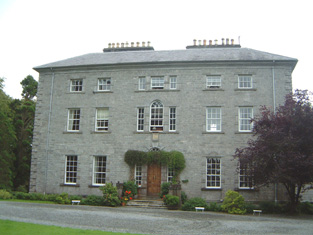
|
| Ballynashee Lodge [Geevagh Lodge] | At the time of Griffith's Valuation Michael Keogh owned Ballynashee Lodge, valued at £22. In 1906 George Keogh was the owner of the mansion house at Ballynashee valued at £22. Lewis also records this house as a seat of the Keogh family in 1837. It is labelled Ballynashee Lodge on the 1st edition Ordnance Survey map but as Geevagh Lodge on the later 25-inch edition of the 1890s. A later building is still extant at the site. | |
| Annagh Lodge | At the time of Griffith's Valuation, Thomas Whitney was leasing a house valued at £12 to Edward Frazer, at Aughnacloy, barony of Tirerrill. In 2006 Annagh Lodge was offered for sale by Raymond Potterton estate agents, in county Meath. The house details claim that Annagh Lodge was built by the Frazer family (from Scotland), around 1800. McTernan, however, notes that the house was reputedly built by a landlord named Hewitson. |

|
| Alderford | At the time of Griffith's Valuation Alderford was leased by the representatives of William F. McDermottroe to Catherine Thompson and was valued at £25. In 1814 it was the seat of Thomas McDermottroe. Lewis also records it as the seat of the latter in 1837. Alderford is famous for its associations with Turlough O'Carolan, the Irish harper, as he died there in 1738 and is buried nearby in Kilronan. This house, however, was built in the early 19th century. It was the seat of Thomas Charles McDermottroe in 1894. It is still extant but in a dilapidated condition. |

|
| Kilronan Castle/Castle Tennison | The house presently occupying this site was constructed in the later 19th replacing an earlier house which had been built c.1820. At the time of Griffith's Valuation the house had been valued at £70 and was occupied by Edward King Tenison. In 1814 it was the seat of Thomas Tennison and is recorded by Lewis as the seat of Col. Tenison. In 1894 Slater referred to it as a residence of the Earl of Kingston. The building is still extant and in 2006-7 was converted into a luxury hotel. For more information on Kilronan Castle see www.kilronancastle.ie. |
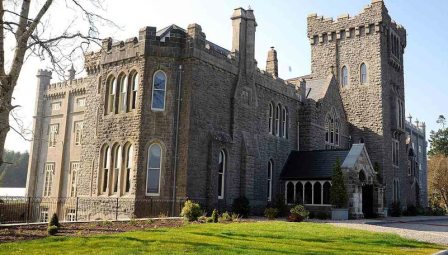
|
| Spotfield | Spotfield appears to have been the property of the Phibbs family in the 19th century but in the 18th century may have been occupied by the White family who had intermarried with the Phibbs. At the time of Griffith's Valuation, it was leased by John Phibbs to Eccles Phibbs. The house was then valued at almost £4. McTernan notes that the house was demolished in the latter part of the twentieth century. | |
| Heathfield (Sligo) | The house at this site was built c.1890 presumably replacing an earlier house listed in Griffith's Valuation, when it was being leased by William Phibbs from the Cooper of Markree estate. At that time it was valued at £6. In 1906 it was owned by Thomas Randle Phibbs and was valued at £22. This later house survives and has been offered for sale in recent years. Ruins of gatelodge and gated entrance visible at G656219. |

|
| Tanzyfort | Tanzyfort House was built by the Cooper family in the mid-17th century and occupied by them until the completion of Coopershill House in 1774. Wilson, however, still refers to it as the seat of Arthur Cooper in 1786. Orser provides a detailed description of the layout of Tanzyfort House. | |
| Castle Island | Also known locally as the Rock of Lough Key, at the time of Griffith's Valuation Viscount Lorton's estate owned a house on Castle Island valued at £14. The original building on the island was a medieval stronghold of the McDermott family to which additions were made in the early 19th century. Renovation work was taking place on these buildings in 2007. |

|
| Grevisk | At the time of Griffith's Valuation Thomas Phibbs Peyton was leasing a house at Grevisk, valued at £10, along with 100 acres, from Viscount Lorton's estate. The Census of 1749 recorded Grevisk as the home of John Nesbit. It is still extant. | |
| Knockvicar | At the time of Griffith's Valuation Charles J. Peyton was leasing a house at Knockvicar, parish of Ardcarn, valued at £15 to Edward Jones. Lewis records the house as the seat of C.J. Peyton in 1837. In 1814 it was the seat of Randal Peyton. | |
| Ballymore | Alex Popham was leasing a house valued at £17 to Andrew Irwin at the time of Griffith's Valuation. Writing in 1786 Wilson refers to Ballymore as the seat of Pooley Shuldham, who may have been connected with the Longford family of that name. In 1814 Ballymore was the seat of Edward Elwood. In 1837 Lewis recorded it as the seat of Rev. J. Elwood. It is described as " a mansion in the possession of the late Rev. Elwood's family" at the time of the first Ordnance Survey. A house is still extant at Ballymore. |

|
| Drumdoe | At the time of Griffith's Valuation, John Wolfe Flanagan was leasing a house at Drumdoe from Viscount Lorton's estate, valued at £28. This house is described as "a good house, formerly the residence of Colonel Lilly" at the time of the first Ordnance Survey. A larger house was constructed some time after this and appears on the 25-inch map of the 1890s. This latter house is still extant. | |
| Mount Erris | At the time of Griffith's Valuation William Duckworth was leasing this house valued at £26 from Viscount Lorton's estate. There is still an inhabited house at this site. |

|
| Knockadoo | Knockadoo was the home of the Knott family in the mid 18th century. Robert Knott was resident there in 1749. Robert Elwood was leasing a house at Knockadoo from Viscount Lorton at the time of Griffith's Valuation. it was valued at £24. In the 1870s it is recorded as the address of Joseph Bennett Little. Earlier, at the time of the first Ordnance Survey it is described as "a fine mansion resided in by Owen Lloyd". A farm is still extant at the site. | |
| Tangier | Caleb Robertson is recorded as occupying the house known at the time of the first Ordnance Survey. He is noted as the immediate lessor at the time of Griffith's Valuation though the house was unocciped and valued at £28. Tangier House was occupied by Harward O'Farrell, a doctor, in the second half of the 19th century. His third son, Sir George Plunkett O'Farrell, was granted arms in 1909. A house is still extant at the site. | |
| The Warren | Caleb Robertson is recorded as the lessor of a property in the townland of Warren or Drum at the time of Griffith's Valuation. It was valued at £25 and leased to a Captain Butler. A house at this site is labelled The Warren on the 25-inch map of the 1890s and a house still exists there. | |
| Millmount | Viscount Lorton was leasing a house valued at £18 at Macmoyne, parish of Boyle, to Nicholas Mulhall, at the time of Griffith's Valuation. This may be the still extant Millmount House, associated with the milling complex. |

|
| Havarine Cottage | Anna Maria Fry was leasing a house valued at £11 from Lord Lorton's estate at Tullyvohaun, barony of Boyle, at the time of Griffith's Valuation. At the time of the first Ordnance Survey Havarine Cottage, at Tullyvohaun, was described as a ''gentleman's seat', the residence of Mrs. Fry. | |
| Frybrook House | Frybrook House was built by Henry Fry, who came to Boyle in 1742, and established a weaving industry in the town. It is still extant. In 2025 it was offered for sale. |

|
| King House | King House was built between 1720-1740 by Sir Henry King. In 1786 Wilson wrote "the Earl of Kingston has a very fine house at Boyle, situated near the ruoins of an ancient abbey". Following a fire in 1788 the King family vacated the house and moved to Rockingham on the shores of Lough Key. King House was used as a military barracks until the 1960s. It is now in the ownership of Roscommon County Council and is open to the public. |

|
| Lough Key House | At the time of Griffith's Valuation, Alicia Peyton was leasing a house valued at £13 at Ballykeevican, barony of Boyle, from Viscount Lorton's estate. This property is now Lough Key House guesthouse. |

|
| Carrickard House | At the time of Griffith's Valuation, Charles Peyton was leasing a house at Keeloges, valued at £25, from Lord Lorton's estate. |

|
| Riversdale House | John R. French was leasing a house valued at £25 at Kilateasheen from the Ecclesiastical Commissioners at the time of Griffith's Valuation. There is no substantial house marked on the 1st edition OS map. This house is still extant and known as Riversdale House. |
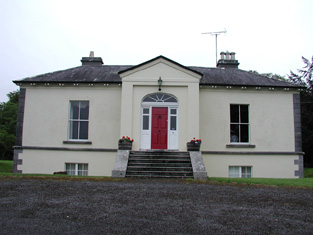
|
| Kingsland | At the time of Griffith's Valuation John Conmee was leasing a property valued at £12 from Viscount Lorton's estate at Kingsland, barony of Frenchpark. He had been in possession of this property since at least 1814. Matthew Conmee also leased a property in the same townland, valued at £6 together with 190 acres, from Lord Lorton's estate. |
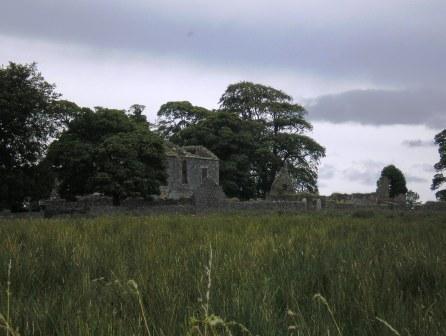
|
| Lyonstown | At the time of the first Ordnance Survey a large ruin, said to have been the residence of the Lyons family, was in the possession of the O'Donnell of Greyfield estate. | |
| Abbey View House | Morgan Crofton, agent to Lord Lorton, was residing here at the time of the first Ordnance Survey. At the time of Griffith's Valuation it was occupied by Caleb Robertson and valued at £34. A house is still extant at Abbey View. |

|
| Rushfield | At the time of the first Ordnance Survey Mr. A. Irwin is noted as the occupier of one of two ''gentlemen's seats' at Tullyvohaun, barony of Boyle. In 1814 it was the residence of John Irwin. This property was valued at £8 and was occupied by William Phibbs at the time of Griffith's Valuation. A substantial farm still exists at the site. | |
| Mount Dodwell | Henry Crichton was the owner of a property valued at almost £7 at Ballinvoher, barony of Corran, in 1906. This may be the cottage which is still extant and was possibly a steward's house. At the time of Griffith's Valuation, it was being leased by Samuel Gilmore from the Creighton estate and was valued at £5. Lewis records Mount Dodwell as the residence of Charles Thompson, who was related to the Dodwell family. This was the original house, which had stood here since the eighteenth century. It ceased to be a residence in the mid-nineteenth century and was subsequently demolished. |

|
| Carrick House | Johnston states that Carrickcoola was owned by the Ormsby Gore estate but was the residence of the McLoghrey family. McTernan indicates that the original house was of two stories but that this was later replaced by a single storey building. The Ormsby Gore estate owned 22 acres of untenanted land in Carrickcoola, barony of Tirerrill, in 1906 but the buildings are not listed. At the time of Griffith's Valuation, Maj. Ormsby Gore owned the townland and was leasing a house valued at only 10s to Thomas McCloghrey together with over 130 acres. | |
| Kingston Lodge | Johnston states that Kingston Lodge was a residence of the McLoghry family. McTernan notes that it is a mid to late nineteenth century building, built by Henry McCloghry, son of Thomas McClogry of Carrickcoola. It was being leased by him from the Cooper estate at the time of Griffith's Valuation and valued at almost £4. The house remained in the McCloghry family until the 1940s and is now in a derelict state. | |
| Ardagh | At the time of Griffith's Valuation Richard Graves Brinkley held extensive property at Ardagh and Bellanascarva, barony of Tirerrill. This had formerly been part of his wife, Hester Lloyd's estate. Ardagh House was then valued at £14. Johnston states that the property at Ardagh was later lived in by Hunter family who acted as agents for the Brinkley estate. Part of the extensive farmyard of Ardagh House has been converted into residential accommodation. An extensive mill complex in the nearby townland of Bellanascarva was leased to Munds Harper at the same time where Brinkley also held a house valued at £30. |

|
| Lissycoyne | At the time of Griffith's Valuation, Patrick McDermott was leasing a property valued at £7 at Lissycoyne, barony of Tirerrill, from the Brinkley estate. It is shown as diminished in size on the 25-inch Ordnance Survey map of the 1890s. Some farm buildings are located at the site now. | |
| Atteville | Both Leet and Lewis indicate that Atteville was the seat of the Knott family with William residing there in 1814. At the time of Griffith's Valuation the property was in the possession of William Phibbs. It is described as a "herd's house" and was valued at almost £2. | |
| Kilfree | At the time of Griffith's Valuation Charles Costello was leasing a property valued at almost £7 together with 140 acres at Kilfree, barony of Coolavin, from the O'Farrell Caddell estate. Lewis records Kilfree as the seat of Edward Costello in 1837. Earlier, in 1802, McParlan mentioned "Mr. Costello of Gortin" as one of the principal residents of the area. McTernan states that the house and estate were eventually sold under the Land Acts. The ruins of the house are still visible. | |
| Ardgallin | At the time of Griffith's Valuation Harloe Baker was leasing a house valued at £7, together with over 80 acres, at Ardgallin, barony of Coolavin, from Viscount Lorton's estate. Lewis also records Ardgallin as the seat of Harloe Baker in 1837. McTernan notes that the Baker family sold their interest to Thomas Bell, of Larkhill House, Quarryfield, in 1887. It came into the ownership of the Cornwall family in the 1920s who are still in possession. | |
| Branchfield (Duke) | At the time of Griffith's Valuation Alexander Duke was leasing property valued at £8 with almost 300 acres, at Branchfield, barony of Corran, from Jemmet Duke. Lewis records Branchfield as the seat of Rev. William Duke in 1837. Wilson notes Branchfield as the seat of Mr. Duke in 1786, remarking that the ruins of Coolteem Castle are nearby. Branchfield House has been offered for sale in recent times. |
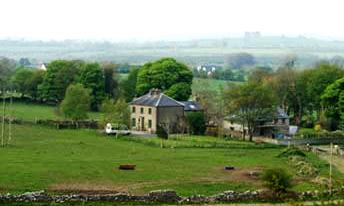
|
| Kilcreevin | Lewis records Kilcreevin as a seat of Jemmett Duke in 1837. Griffith's Valuation shows that Jemmett Duke was leasing over 250 acres from the Coopers of Markree in this townland including a property valued at £2. |
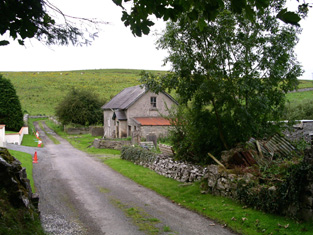
|
| Kilmorgan | Jemmet Duke held 220 acres at Kilmorgan, barony of Corran as well as a property valued at £5 at the time of Griffith's Valuation. Lewis had recorded Kilmorgan as the seat of Robert Weir. McTernan notes that Kilmorgan had belonged to the Trumble family but was sold by them in 1855. The site is now occupied by farm buildings. | |
| Knockalass House | At the time of Griffith's Valuation, Patrick Graham was leasing a house at Knockalass, barony of Corran, valued at £5 together with 75 acres from the Gore Booth estate. McTernan notes that the Grahams were initially tenants and later owners in fee. |

|
| Carrickard | At the time of Griffith's Valuation, Rev. Arthur Hyde was leasing a house at Carrickard, barony of Tirerrill from the estate of Robert Gough. The house was valued at £8. | |
| Brick Field | At the time of Griffith's Valuation William Phibbs held a property valued at £6 at Knockbrack, barony of Corran. In 1906 this property was valued at £11. | |
| Drum Lodge | One of the many surviving gatelodges on the Rockingham Demesne. |

|
| Andresna | Meredith Thompson was leasing a property valued at £6 at Andresna, barony of Tirerrill, to William Thompson at the time of Griffith's Valuation. | |
| Castlefield House | At the time of Griffith's Valuation Meredith Thompson, senior, was occupying a house valued at over £5 at Anresna, barony of Tirerrill. This appears to be the house marked on the OS map as Castlefield House, on the shores of Lough Arrow. McTernan notes that it later came into the possession of the Acheson family who sold it in 1935. It is still extant but in 2009 was unoccupied. | |
| Keenaghan Mill | At the time of Griffith's Valuation John and Henry Gorman were leasing an extensive milling complex at Keenaghan, barony of Corran from Robert Gore Booth, then valued at £83. |

|
| Somerton | Somerton House appears to have been the residence of the agent to the Perceval estate. At the time of Griffith's Valuation the latter estate was owned by R.W. Hall-Dare. Somerton was then occupied by Christopher L'Estrange and was valued at £14. It is still extant. |

|
| Derroon House | Derroon House is recorded on the 1st edition OS map. At the time of Griffith's Valuation, Capt. Richard Gethin was leasing a property at Derroon from the Gore-Booth estate valued at almost £3. | |
| Greyfort Cottage | At the time of Griffith's Valuation, Nicholas Gardiner was leasing a herd's house valued at £4 and lands from the Nicholson estate. This property is labelled Greyfort Cottage on the 1st edition Ordnance Survey map but it is not shown on the later 25-inch edition of the 1890s. | |
| Straduff Lodge | Patrick Martin was leasing a property valued at £3 from the Keogh estate at Straduff, parish of Kilmactranny, at the time of Griffith's Valuation. This property appears on the 1st edition OS map as Straduff Lodge. It is no longer extant. | |
| Larkhill | A late nineteenth century house which replaced an earlier residence on an adjacent site. Held by the Greer family from the Perceval estate at the time of Griffith's Valuation, when the house was valued at £1. The property was later acquired by the Bell family who built the existing house. Purchased in the twentieth century by the Taylor family and still extant and occupied. | |
| Quarryfield | McTernan notes that Robert Howes of Bunninadden and Quarryfield married Jane Irwin of Mount Irwin in 1754. Subsequently the then house at Quarryfield alternated between Howes and Irwins. In the 1840s the property was purchased by Col.Perceval of Templehouse and later in the nineteenth century by the Coopers of Markree, by whom the present house was built in 1887. The house had a number of owners since and is still extant and occupied. |
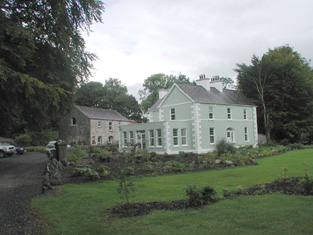
|
| Cloontykilla Castle | This building was constructed after the publication of the first Ordnance Survey Map. It appears to have functioned as a shooting/fishing lodge for the King estate. It is now a ruin. |
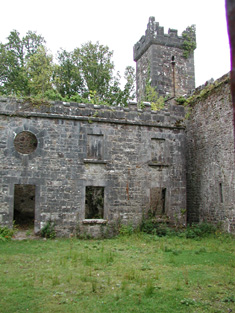
|
| Crohy House | Crohy House was occupied by Francis Foster, leasing from the Conyngham estate at the time of Griffith’s Valuation. | |
| Roshin Lodge | Francis Foster was occupying Roshin Lodge at the time of Griffith’s Valuation. It was leased from the Conyngham estate and valued at £18. Foster's daughter, Mary Stewart Foster, married John Stouppe Charley of Belfast. She sold the property after his death. In 1876 it was offered for sale by Arthur Sandys Forster. Roshin Lodge was described as 'a spacious dwelling house, comprising 29 apartments' at that time. By 1901 it was the residence of William Smyth and his family. He had died by 1911 but his widow and children still occupied the property. |

